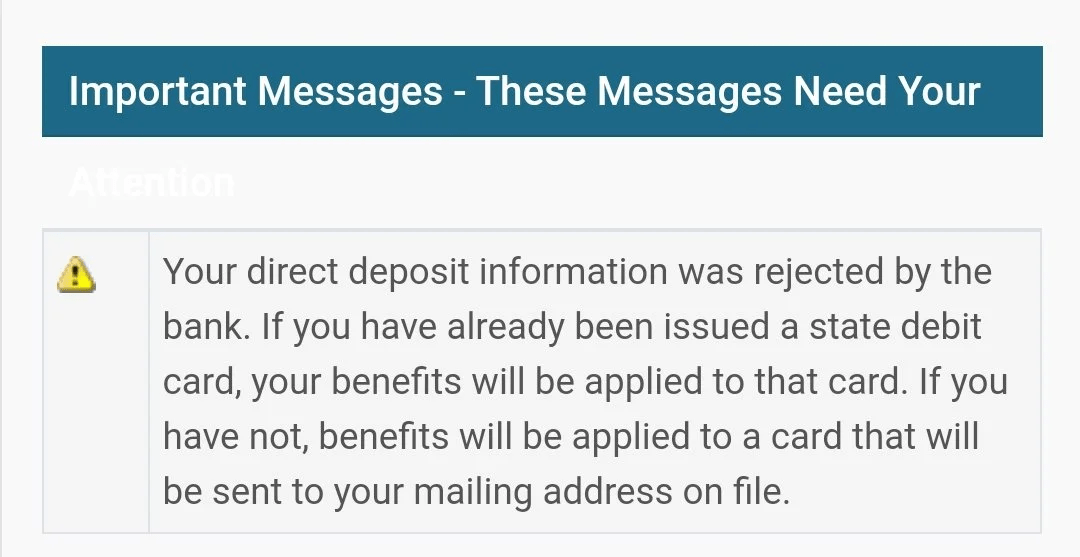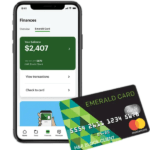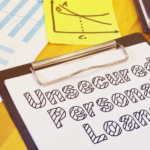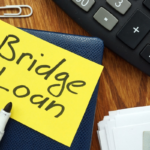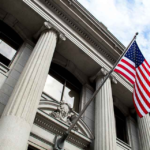The Account Number is INVALID
The account number is Invalid is indeed one of the reasons a bank reject a direct deposit. This may happen if the recipient provided incorrect account information. Such as a typo in the account number, to the payer or if the recipient changed bank accounts and failed to update the information with the payer.
It’s important to ensure that the correct BANK ACCOUNT information is provided to the payer and updated promptly to avoid this issue.
There are insufficient funds
Yes, insufficient funds in the recipient’s bank account is another reason a bank reject a direct deposit. If there are not enough funds available in the Bank Account to cover the deposit. The bank may reject the transaction.
This can create financial difficulties for the recipient, especially if they rely on direct deposit for essential expenses. To avoid this situation. The recipient should monitor their account balance and ensure enough money is available to cover expected deposits. Your refund can get be pending in bank account.
The Deposit Was Made From An UNRECOGNIZED Or UNLICENSED ENTITY
The deposit is made from an unrecognized or unlicensed entity is another reason a bank may reject a direct deposit. Banks have security measures in place to protect their customers from fraudulent activity. If a deposit originates from an entity that is not recognized or licensed. The bank may reject the deposit as a precautionary measure.
This may also occur if the deposit is made from an entity that is not in compliance with regulatory requirements. To avoid this issue, the recipient should verify the legitimacy of the payer before providing their account information.
The Deposit Amount Is Too Large For The Current ACCOUNT BALANCE
Yes, the deposit amount being too large for the current account balance is a reason a bank reject a direct deposit. If the deposit exceeds the available balance in the recipient’s account, the bank may reject the transaction to prevent overdraft fees or other penalties.
This may also happen if the deposit exceeds the daily deposit limits set by the bank. To avoid this issue, the recipient should monitor their account balance and ensure that there are sufficient funds available to cover expected deposits.
There Are DISCREPANCIES In The Name
Discrepancies in the name or other information contained in the deposit and in the recipient’s most recent account statement are another reason a bank may reject a direct deposit. This may occur if the payer entered the recipient’s information incorrectly or if there has been a change in the recipient’s name or account information that was not updated with the payer.
To avoid this issue, it’s important for the recipient to ensure that their account information is up-to-date and correct and to update the payer if there are any changes promptly.
The Bank Suspects Fraudulent Activity
If the bank suspects fraudulent activity and cannot confirm the recipient’s authorization to make a direct deposit into their account, it may reject the deposit as a security measure. Banks take fraud very seriously and have processes in place to detect and prevent it.
If the bank suspects that the direct deposit may be part of a fraudulent scheme, it may reject the deposit and take other steps to protect the recipient’s account, such as placing a hold on the account or contacting the recipient to confirm the legitimacy of the deposit. To avoid this issue, it’s important for the recipient to monitor their account regularly and to report any suspicious activity to their bank as soon as possible.
The bank needs more information regarding the SOURCE OF FUNDS
Yes, the bank needing more information regarding the source of the funds before they can honor a direct deposit request is another reason a bank may reject the deposit. Banks have regulations they must follow to prevent money laundering and other illegal activities, and they may need additional information to verify the source of the funds being deposited.
This may also occur if the deposit originates from a country that is subject to economic sanctions or is deemed to be a high-risk location. To avoid this issue, the recipient should verify the legitimacy of the payer and be prepared to provide additional information if requested by their bank.
You Have A Negative Balance
Yes, if the recipient has a Negative Balance in their account, the bank may reject the direct deposit to avoid automatically debiting the account without the recipient’s consent. When a recipient has a negative balance, the bank may charge overdraft fees or other penalties, which can add to the recipient’s financial difficulties.
To avoid this situation, the recipient should monitor their account balance and ensure that there are sufficient funds available to cover expected deposits. If the recipient has a negative balance, they may also want to contact their bank to discuss options for resolving the issue.
The Bank Has Determined There Are Suspicious Activities Associated With Your BANK Account
Yes, if the bank determines that there are suspicious activities associated with the recipient’s account. It may reject a direct deposit as a security measure and to protect the recipient’s funds. Banks have processes in place to detect and prevent fraudulent activity. If the bank suspects that the recipient’s account may have been compromised. It may take steps to investigate and resolve the issues before allowing any further activity.
This may include placing a hold on the account. Contacting the recipient to confirm the legitimacy of the deposit, or taking other steps to secure the recipient’s funds. To avoid this situation, the recipient should monitor their account regularly. Report any suspicious activity to their bank as soon as possible.
The Cheque Is Not Signed By The Drawer
Yes, if a cheque deposited into the recipient’s account is not signed by the drawer. The bank may reject the deposit. A cheque is a legal document, and for it to be honored by a bank. It must meet certain requirements, including having a signature from the drawer.
If the cheque is not signed, the bank may reject the deposit and return the cheque to the recipient. As it cannot be processed without the necessary signatures. The deposit has the necessary signatures and meets all other requirements set by the bank.
The Cheque Has Already Been Paid
Yes, if a cheque has already been paid, the bank may reject the deposit. A cheque is considered to be paid when the funds have been transferred from the drawer’s account to the recipient’s account. If a recipient tries to deposit a cheque that has already been paid, the bank may reject the deposit and return the cheque to the recipient.
To avoid this issue, the recipient should verify that a cheque has not been paid before attempting to deposit it and ensure that they are not depositing a duplicate cheque. The recipient may also want to check with the issuer of the cheque to confirm that the funds have not been transferred.
The Cheque Is Post-Dated
Yes, if a cheque is post-dated, the bank may reject the deposit. A post-dated cheque is a cheque that has a future date written on it. Banks typically do not process post-dated cheques until the date written on the cheque has arrived. If a recipient tries to deposit a post-dated cheque before the date written on it, the bank may reject the deposit and return the cheque to the recipient.
To avoid this issue, the recipient should verify the date of the cheque before attempting to deposit it and ensure that they are not depositing a post-dated cheque. The recipient may also want to check with the issuer of the cheque to confirm the intended date of payment.
There Is A DISCREPANCY In The Name Of The Payee And Drawer
Yes, if there is a discrepancy between the Payee and drawer on a cheque, the bank may reject the deposit. The payee is the person or entity to whom the cheque is made payable, while the drawer is the person or entity who wrote the cheque.
For a cheque to be processed, the name of the payee must match the name of the recipient’s bank account. The name of the drawer must match the name of the account from which the funds are being drawn. To avoid this issue, the recipient should verify the names on the cheque. Their bank account match before attempting to deposit the cheque.
The Amount Of The DEPOSIT Is Not One Whole Number
Yes, if the deposit amount is not a whole number, the bank may reject the deposit. Most banks require that the total amount of the deposit be in a specific format. Such as a whole number or a number with a limited number of decimal places. If the amount of the deposit does not meet the bank’s requirements. The bank may reject the deposit and return the cheque to the recipient.
To avoid this issue, the recipient should verify that the amount of deposit meets the bank’s requirements before attempting to deposit the cheque. Additionally, the recipient may want to check with the issuer of the cheque to confirm the intended amount of payment.
The Payee’s Bank Account Number Is Invalid Or Missing
Yes, if the payee’s bank account number is invalid or missing, the bank reject a direct deposit. Direct deposits are processed electronically, and the bank needs the recipient’s correct bank account number to route the deposit to the correct account. If the account number is invalid or missing. The bank may reject the deposit and return the funds to the sender.
To avoid this issue, the recipient should verify. That, their bank account number is correct and provided to the sender before attempting to receive a direct deposit. If the recipient is unsure of their account number, they can contact their bank for assistance.
There Are More Than 3END In A Row On The direct deposit Cheque
Yes, if there are more than three consecutive “END” symbols on a cheque, the bank reject a direct deposit. Some banks have security measures in place to detect potential fraud and protect their customers’ accounts. The presence of more than three consecutive “END” symbols on a cheque may indicate. That the cheque has been altered or tampered with, and the bank may reject the deposit as a precautionary measure. To avoid this issue, the recipient should verify. That, the cheque is authentic and has not been altered in any way before attempting to deposit it. If the recipient is unsure whether the cheque is authentic. They can contact the issuer of the cheque or their bank for assistance.
You Have direct deposited A Foreign Currency Cheque
Yes, if you have deposited a foreign currency cheque, the bank may reject the deposit. Most banks in the US do not process foreign currency cheques. As they need to be converted to US dollars before they can be processed. If you deposit a foreign currency cheque. The bank may reject the deposit and return the cheque to you. Along with instructions on how to obtain the equivalent US dollar value of the cheque. To avoid this issue, it is important to verify with your bank. If they accept foreign currency cheques and if not, take the necessary steps. To convert the cheque to US dollars before attempting to deposit it. If you are unsure how to do this, you can contact your bank for assistance.
CONCLUSION
In conclusion, there are various reasons why a bank reject a direct deposit. This could include issues with the account number, insufficient funds, unrecognized deposit source, large deposit amount, discrepancies in personal information, suspicion of fraudulent activity, negative account balance, suspicious account activity, and invalid or missing information on the deposit, such as a missing or invalid bank account number or signature. Additionally, a bank may reject a deposit if it is in a foreign currency, post-dated, or has already been paid. It is important to verify all information and ensure that all criteria are met. Before, attempting to make a direct deposit to avoid rejection and ensure a smooth and successful transacti
